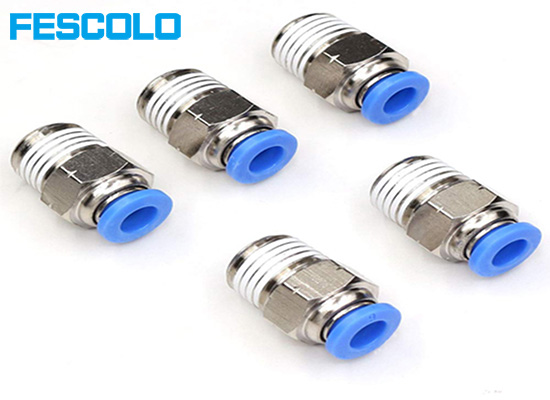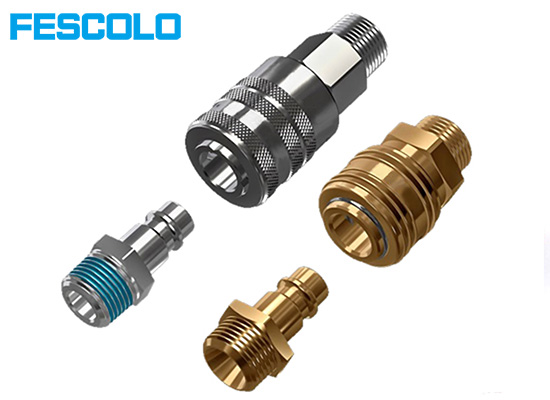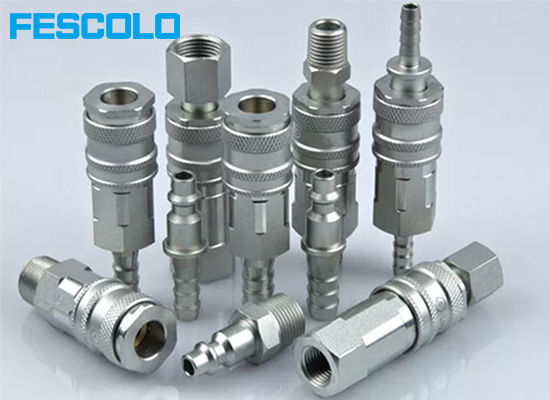May 27, 2025
With the rapid advancement of smart manufacturing and Industry 4.0, fields such as precision machining and robotic automation have become the new frontier for pneumatic technologies. As a vital component of pneumatic systems, pneumatic quick couplings play a crucial role. This article will delve into their materials, functions, and structural characteristics, aiming to help you choose the most suitable coupling to ensure both enhanced efficiency and reliability.
A pneumatic system is an automated system that uses compressed air as the working medium. It controls the flow of gas through various pneumatic components to achieve energy conversion and signal control. Pneumatic systems are widely applied in industrial automation, packaging machinery, assembly lines, food processing equipment, pharmaceutical devices, and more. They offer advantages such as simple structure, fast response, and environmental cleanliness.
The basic composition of pneumatic systems is similar to hydraulic systems and mainly includes the following five core components:
Power Components: These generate compressed air and provide the air source, such as air compressors.
Actuating Components: Convert the energy of compressed air into mechanical motion, including pneumatic cylinders and pneumatic motors.
Control Components: Regulate airflow direction, pressure, and speed, such as angle seat valves, axial valves, diaphragm valves, and various pneumatic solenoid valves.
Transmission Components: Form the pneumatic piping system, transporting compressed air between components, connecting various pneumatic parts, and ensuring airtightness. This includes pneumatic tubes and pneumatic fittings.
Auxiliary Components: Provide auxiliary functions like filtration, lubrication, noise reduction, and system stabilization. These include filters, pressure regulators, lubricators, etc.

The pneumatic piping system refers to the pipeline network used to transport compressed air, connecting the air source, control valves, actuators, and other pneumatic components while ensuring system airtightness. It includes pneumatic tubes and fittings of various materials and types.
The pneumatic piping system primarily serves to:
Transmit compressed air
Connect various pneumatic components
Ensure smooth airflow without leakage
Since the piping comes into direct contact with the working fluid, it must have characteristics such as high pressure and temperature resistance, chemical resistance, and corrosion resistance. Therefore, the materials used must meet these requirements.
Polyurethane Tubing: Flexible, pressure-resistant, widely used
Nylon Tubing: High-pressure resistant, good rigidity
Polyethylene Tubing: Low-cost, mostly for low-pressure systems
Metal Tubing: For high-strength or special environments
Pneumatic fittings are specialized components that connect pneumatic tubes to other components, ensuring sealed, smooth, and safe airflow within the system. They are essential connectors in pneumatic piping systems. With the rapid growth of industrial automation, the number of pneumatic components and the complexity of piping has increased, resulting in frequent assembly and disassembly. This creates demand for a new type of connection that is "tool-free, quick-connect/disconnect, and reliable sealing," leading to the development of pneumatic quick couplings.
Pneumatic quick couplings are connector components used for fast connection and disconnection of pneumatic piping or equipment. They feature tool-free, one-handed operation and automatic sealing. They are widely used in industrial automation, assembly lines, testing platforms, pneumatic tools, and other applications.
In the production process of pneumatic quick couplings, high-precision machining is typically performed within a tolerance of ±0.01 mm. The components are then assembled automatically by robotic systems. Embedded IIoT sensors enable real-time data collection, measuring parameters such as pressure, temperature, and sealing integrity. This data supports online inspection and quality tracking, triggering alerts or automatic rejection when deviations from standards occur. As a result, the quality consistency and stability of each coupling are ensured, while significantly reducing manual intervention and rework rates.

Quick Connection: Allows operators to connect and disconnect using one hand, simplifying installation, debugging, and maintenance processes.
Automatic Sealing: Automatically shuts off airflow when disconnected, preventing compressed air leakage and improving safety.
Foolproof Positioning: Designed to prevent incorrect connections, ensuring proper mating. Some models also feature locking mechanisms to prevent loosening.
Reusable: Manufactured to industrial-grade quality standards, capable of withstanding frequent connections and disconnections, ideal for tools or modules that are regularly swapped.
Compatibility: Suitable for various pneumatic tools, equipment, and pipeline ends. Some models also support liquid or vacuum fluid transmission.
Pneumatic quick couplings generally consist of two parts:
Female Coupling:
Contains an automatic locking mechanism with steel balls and springs, equipped with an automatic sealing valve, and installed at the fixed end.
Male Coupling:
Inserts into the female coupling to trigger locking and open airflow; usually connected to the hose or tool end.
Spring: Provides return force to control locking and sealing actions.
Steel Ball Lock: Ensures quick and secure male-female connection.
Sealing Ring: The primary component ensuring airtightness, effectively preventing air leakage.
Valve Core: Automatically shuts off airflow when disconnected.
Since pneumatic quick couplings contact the working medium directly, their materials must have properties like heat resistance, high pressure tolerance, corrosion resistance, and chemical resistance. Common materials include:
Nickel-Plated Brass: Corrosion-resistant, cost-effective, versatile, suitable for most industrial equipment.
Stainless Steel: High strength, corrosion-resistant, ideal for clean rooms, food processing, chemical, and pharmaceutical industries.
Engineering Plastics: Lightweight, low cost, used for small devices or non-critical connections.
Aluminum Alloy: Lightweight with moderate strength, used in equipment requiring weight reduction or handheld pneumatic tools.

By Disconnection Method:
Single Shut-Off: The female coupling automatically shuts off airflow upon disconnection; standard and common type.
Double Shut-Off: Both male and female couplings shut off airflow when disconnected; used where bidirectional sealing is required.
Full Flow: No shut-off valve; allows uninterrupted fluid flow during connection or disconnection, suitable for vacuum or low-pressure applications.
By Connection Method:
Push-In Type: Locks upon insertion, commonly used for flexible hose connections.
Threaded Type: Internal or external threads for a more secure connection.
Ferrule Type: Used with rigid tubing, offering strong sealing.
Flanged Type: For heavy-duty, large-diameter connections.
By Standards and Shapes:
ISO 6150-B: International standard, compatible with multiple brand male/female couplings.
European Style: Strong locking force and excellent sealing, used in high-demand industrial systems.
Japanese Style: Compact structure, smooth connection and disconnection, common in Asia.
American Style: Smaller plugs, used in handheld tools and automated equipment.
Rapid tool changes on assembly lines.
Quick connect/disconnect in testing stations and air tightness test equipment
Portable air supply systems and mobile pneumatic devices
Frequent module replacement in laboratories or clean rooms
Modular air supply connections in automated production units
Regardless of the application industry, under the trend of smart manufacturing, the integration of IIoT and 5G networks will enable high-frequency real-time data transmission and remote fault diagnosis, paving the way for industrial digital twins and predictive maintenance capabilities. As a result, the maintenance and performance monitoring of pneumatic couplings will become increasingly intelligent.
You May Interest In

May 22, 2025 Blog
Comprehensive Guide to Hydraulic Quick CouplersFOKCA ©1998-2025 Fescolo Pneumatic All Rights Reserved Sitemap